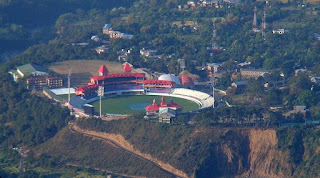Dharamshala
Dharamshala likewise spelled Dharamshala is the colder time of year capital city of Himachal Pradesh, India. It has filled in as the area for the regulatory central command of the Kangra region after they were moved from Kangra, a city 18 kilometers (11 mi) away from Dharamshala, in 1855.
The city has been chosen as one of the hundred in India to be created as a savvy city under Indian Prime Minister Narendra Modi's lead Smart Cities Mission. On 19 January 2017, the Chief Minister of Himachal Pradesh, Virbhadra Singh, broadcasted Dharamshala as the second capital of Himachal Pradesh, making it the third territory of India to have two capitals after Maharashtra and the Indian-oversaw affiliation area of Jammu and Kashmir.
Portrayal
In spite of the fact that larger part of tea cultivates in Kangra District are situated in and around Palampur, Dharamshala additionally has a few tea gardens which are unmistakably around Sheela Chowk and stretch out northwards to Khaniyara. The tea is known as Dharamsala or Kangra tea, is extremely famous across India and the remainder of the world. Customarily known for Kangra green tea, Dharamshala presently creates all teas including dark tea, green tea, oolong tea and white teas notwithstanding the famous Kashmiri Kahwa and Masala Chai.
History
Prior to the British Raj
Until the British Raj, Dharamshala and its encompassing region was governed by the Katoch Dynasty of Kangra, an imperial family that controlled the area for two centuries. The regal family actually keeps a home in Dharamsala, known as 'Mists End Villa'. Under the British Raj, the locales were important for unified territory of Punjab, and was managed by the legislative heads of Punjab from Lahore. The Katoch administration, albeit profoundly respected socially, had been diminished to status of jagirdars (of Kangra-Lambagraon) under the Treaty of Jawalamukhi, endorsed in 1810 between Sansar Chand Katoch and Maharaja Ranjit Singh of Sikh Empire. The native individuals of the Dharamshala region (and the encompassing district) are the Gaddis, a prevalently Hindu gathering who customarily carried on with a migrant or semi-itinerant transhumant way of life. Because of the absence of extremely durable settlements nearby, a few Gaddis lost their occasional fields and farmland when the British and the Gurkhas showed up to settle.
Settlement by the British and the Gurkhas
Holy person John's Church in The Wilderness at Dharamshala worked in 1852
The burial place of James Bruce, eighth Earl of Elgin at St. John in the Wilderness Church
In 1848, the region currently known as Dharamshala was attached by the British.
It initially shaped an auxiliary cantonment for the soldiers positioned at Kāngra, and was first involved as a station in 1849, when a site was needed for a cantonment to oblige a Native regiment which was being brought up in the District. A site was found upon the grades of the Dhola Dhār, in a plot of waste land, whereupon stood an old Hindu resthouse, or dharmsala, whence the name took on for the new cantonment. The common specialists, following the case of the regimental officials, and pulled in by the upsides of environment and landscape, constructed themselves houses in the neighborhood of the cantonment; and in 1855 the new station was officially perceived as the base camp of the Kāngra District.
An ideal situation for the new base was found on the slants of the Dhauladhar Hills, close to the site of a Hindu safe-haven, or Dharamshala, henceforth the name of the town. The Battalion was subsequently renamed the memorable first Gurkha Rifles, this was the start of the legend of the Gurkhas, otherwise called the 'Most intrepid of the Brave'. Thusly, fourteen Gurkha company towns developed from this settlement, and exist right up 'til today, to be specific Dari, Ramnagar, Shyamnagar, Dal, Totarani, Khanyara, Sadher, Chaandmaari, Sallagarhi, Sidhbari, Yol, etc. The Gurkhas venerated at the antiquated Shiva sanctuary of Bhagsunag. The Gurkhas alluded to Dharamshala as 'Bhagsu' and alluded to themselves as Bhagsuwalas.
The 21st Gurkha Regiment from Dharamshala performed chivalrous accomplishments during World War I and the North West Frontier Province crusades. The Gurkha cantonment then, at that point, arrived at its pinnacle during World War II, when brigades from Dharamshala left a mark on the world. Many spot names in the town actually hold their previous cantonment phrasings: Depot Bazaar, Pensioners' Lines, Tirah Lines (named after the nineteenth century Tirah Campaign), Bharatpore Lines (named after the 1826 Battle of Bharatpore).

















0 Comments